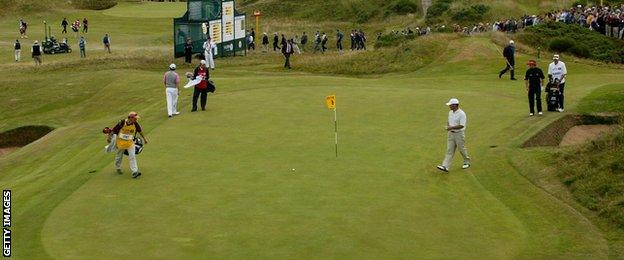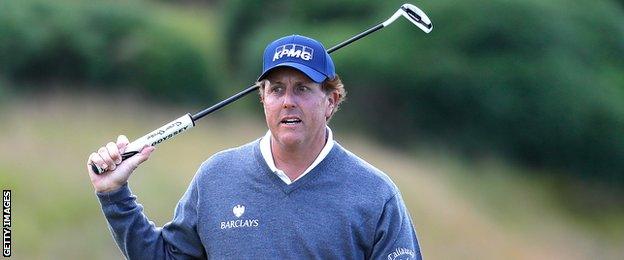The Open 2016: Troon's famous Postage Stamp will 'cause carnage'
- Published

The Postage Stamp hole at Royal Troon is set to offer a unique challenge at the Open Championship
It is 138 years old and 123 yards long, the shortest hole in Open championship golf and yet one of the most beloved unless you happen to be the hapless German amateur, Hermann Tissies, who took five to get out of a greenside bunker on his way to a 15 here in The Open of 1950.
Alas poor Hermann, but he wasn't the only one to disappear without trace at Troon's storied par-three hole.
Twenty-seven years before Hermann, Gene Sarazen's chances went south when he took five and lost the Claret Jug by one to Arthur Havers. And 74 years after Sarazen, a young superstar was going nicely in the final round of the Open when he fetched-up at the famous eighth hole.
Six shots later, Tiger Woods' challenge was done.
Designed by Willie Fernie, the Open champion of 1883, given its name by Willie Park Jnr, the Open champion of 1887 and 1889 and refined by James Braid, five-time Open champion between 1901 and 1910, the Postage Stamp is in the pantheon of great par threes.
History? It's all around you out there on the patch of land that is about to host the 145th Open. The tee-box at the top of a dune, a long and narrow green carved out of sand hills. Standing guard, like malevolent sentries, five cavernous bunkers that spell trouble, at best, and death, at worst.
Hit it high and the wind might kill it. Hit it low and it's tough to stop it. Hit it short or right or left and you're not quite in Hermann country but you're in a bad place, a circle of hell for some.

"The Postage Stamp is great architecture," says former Ryder Cup captain Paul McGinley
Talk to a few of golf's best thinkers and many of them smile when the Postage Stamp is mentioned. To them, it's not just a golf hole, it's more than that. It's the way golf should be.
We now live in an age where major championship par threes can push on for 300 yards long, and where the game's only answer to technology is to make courses ever longer, ever more brutal. "We're losing that skill element in golf," says Ryder Cup winning captain Paul McGinley. "The Postage Stamp is great architecture. It's not about distance, it's about course management, it's about shaping a shot, it's about touch and feel."
Thomas Bjorn is of a like mind. "It shows that this game doesn't have to be controlled by the equipment," said the Swede. "It's not about what's long, it's about what's really well designed."
Five shortest holes in the current Open rota | ||
|---|---|---|
Course | Name of hole | Yards |
Royal Troon | Postage Stamp - 8th | 123 |
Royal Portrush "Dunluce" | Islay - 3rd | 155 |
Royal Portrush "Dunluce" | Feather Bed - 11th | 170 |
St Andrews "Old Course" | Short - 8th | 174 |
St Andrews "Old Course" | High (in) - 11th | 174 |
In 2014, BBC Scotland asked 20 top players - who'd won a combined 11 Claret Jugs and almost 400 tournaments worldwide - to name their favourite Open championship hole. It came down to two - the Postage Stamp at Troon and the Road Hole at St Andrews were locked together on six votes each.
Rory McIlroy, Ian Poulter, Nicolas Colsaerts, Louis Oosthuizen, Sam Torrance and Stephen Gallacher went with the Road Hole. Ernie Els, Luke Donald, Paul Casey, Paul McGinley, David Howell and Darren Clarke went with the Postage Stamp.
The casting vote went to 2013 Open champion Phil Mickelson. The American went for the par three. "Challenging a player for his precision as opposed to solely length is a lost art," said Mickelson at Castle Stuart earlier in the week. "The Postage Stamp is a perfect example of how you can challenge the best players in the world. I would love to see that implemented more."
The Postage Stage demands accuracy over length, brain over brawn. It's a tease, a siren with a touch of the devil. In dead calm, it's a birdie hole. In the wind - different story.
"It was a little dinky eight-iron for me when I played it last week," says Henrik Stenson. "Most of the good par threes in golf are probably ranging between 123 to maybe 180 yards. I'm not a big fan of the new four-iron or three-iron par threes.
"Of these little ones, the 17th at Sawgrass, the Postage Stamp - you hit a good shot, you make two, you hit a bad one you can walk away with a five. You can have a three-shot swing on a pitching wedge. If you're the kind of fan that wants to see carnage I can highly recommend going out to that eighth hole and sitting in that grandstand on a difficult day."

Phil Mickelson said "The Postage Stamp is a perfect example of how you can challenge the best players in the world."
"There's going to be carnage," says former US Open winner Graeme McDowell. "If the wind blows in the direction I was playing it in last week you're going to have all kinds of numbers. The bunker pin-high right is unplayable. I hit six-iron. The next day I hit eight. It's a very changeable golf hole."
Scotland's Colin Montgomerie spoke about the outward seven holes at Troon and the feeling he gets when he plays them. All relatively downwind, all fairly straightforward. "I think, 'OK, I can do this, I can plot my way around here'," says Montgomerie. "And then you get to the eighth hole and it's the first one that turns into the wind.
"Even in a practice round you stand up there and it's a potential card-wrecker. Always was and always will be. It does bring to mind the great par threes in the world of golf - Pebble Beach's seventh, the 12th at Augusta, and the eighth at Royal Troon and they're all short holes.
"It's amazing how one can design a course back in the 1870s and it still stands the test of time today. Fantastic. Nearly 150 years old and it can still generate excitement and drama."
McGinley uses the Postage Stamp as an example of not just what a great golf hole should be but as an illustration of how far golf is getting away from artistry. "It's just brilliant and it shows that if you get clever green designs and just a bit of thought then you don't need massive length to challenge players.
"The wind at the Postage Stamp is a big factor, you have a very small target and the margin for error is tiny. You don't have to be far off line for it to be trouble. You have seven or eight yards of width to hit it into.
"I like watching the ball as it hits the green because that tells you what shape you've put on the shot. Normally it plays a little bit into the wind, in off the right. You need to hold the shot in there, which is a difficult skill with a loft on the club. With loft, it's easier to hook the ball but a lot harder to hold it. That's what creates the skill level.

American Craig Stadler celebrates a hole in one at the Postage Stamp in the 2008 Senior Open Championship
"We're losing that skill from the game, absolutely. Firm and fast fairways and greens call for course management and short par threes do the same. We're not seeing course management much any more.
"The Postage Stamp is all about course management and ball control. It's about who can hold it in that wind, who can play it the right way and create the right spin on the ball so that when it hits the green, it stops. If you get it right, great. If you get it wrong, watch out."
There is another way of playing it, of course. Sarazen was 71 years old when he arrived at Troon for the 1973 Open, the 50th time he'd competed for the Claret Jug.
In his opening round, he punched a five-iron on to the green at the Postage Stamp and it rolled all the way into the hole for an ace. The day after, the great man found sand off the tee, then promptly holed his bunker shot for a birdie.
Sarazen's heroics add to the legend of the hole. Its majesty and danger have long since been written into the folklore of the game.
- Published8 July 2016

- Published9 July 2016

- Published8 July 2016

- Published28 September 2018

- Published8 August 2017

- Published13 May 2016

- Published19 July 2016
